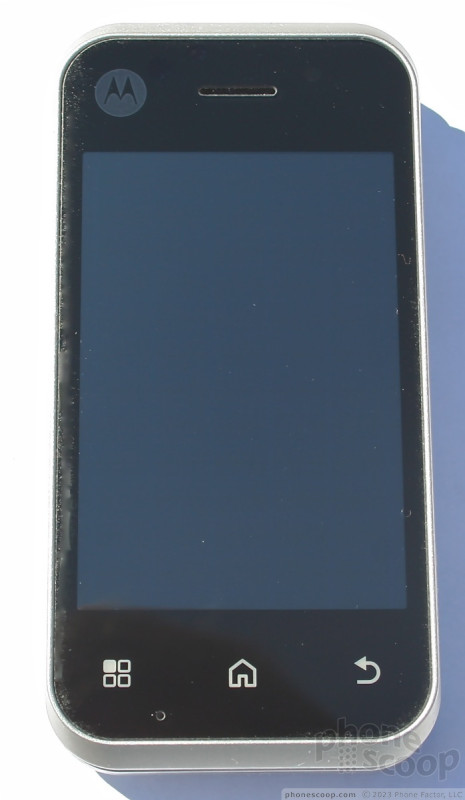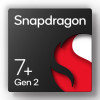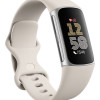Review: Motorola Backflip
The Backflip is not the most svelte device on the market, but its good looks make up for a slightly chubby footprint. It is made with metal and plastic materials that have a high-quality feel to them. Construction is rock solid. The hinge is one of the strongest I've ever encountered. The solidity comes at a price: weight. It's a heavy phone. With its blocky shape and weight, you feel it in your hand and you'll feel it in your pants pocket. This phone is not going to be friendly to tight, hipster jeans. I'd also avoid dropping it on your foot when you aren't wearing shoes. It's gonna hurt.
The front of the Backflip has the display, framed in back, and three capacitive touch buttons underneath. These buttons work pretty well and offer haptic feedback as they are pressed. The Backflip's trick feature is that the keyboard is stowed on the back surface of the device when it is closed. That means the keyboard is always exposed. Rotate the Backflip counterclockwise to open and use the physical QWERTY keyboard. Motorola said it chose this design both because it is unique and because it let Motorola create a larger keyboard for the device.
The keyboard is an interesting animal. Without a doubt, I can say that it is better than all of the other keyboards that Motorola has designed for its Android devices — but that's not saying a lot. The keyboards on the Droid and the Cliq are poor. The keys of the Backflip's QWERTY are large and well spaced. They have just the right amount of travel and feedback. My problem with the Backflip is the shape of the keys. Because the keyboard is always going to be exposed (in your pocket, in your bag, purse, etc.), Motorola had to minimize the profile of each key. The keys are essentially flat, with a minute gap to let users tell them apart. Long story short, I didn't like typing on the Backflip. It is too difficult to tell the keys apart by feel when typing quickly, and that makes for error-filled text.
On the plus side, Motorola did include some specialized keys. These include shortcuts that launch the browser, launch the search tool or initiate a text message. There are navigation keys and keys to open the menu and return to the home page. Thankfully, there are dedicated period and comma keys. There are no keys that make typing easier, such as an emoticon key or a ".com" key, etc. Worried about how tough the keys are, and how quickly they'll break off? Don't be. Motorola did a very good job making the keyboard a tough unit. Since the keys are not individual buttons, you don't have to worry about them getting snagged on anything. The surface of the keyboard is also scratch resistant. I took the edge of a quarter to it and punished it a bit. It survived without so much as a nick.
The Backflip's other neat-o feature is a touch pad, like on a laptop. Where is this touch pad, you ask? On the back of the phone, on the surface behind the display. It can only be used when the phone is open. Motorola decided that it might help on-screen navigation when holding the device if people can use their index fingers to navigate around the screen. It takes a little bit of getting used to, but after some adjustment I really liked it.
Finishing our tour around the Backflip, there is a lock/power key on the top. It has good travel and feedback, though it's a bit harder to find with your finger than I'd like. A 3.5mm headset jack is next to it, which means users can take advantage of their own headphones if they wish. The volume toggle is on the right side of the Backflip, close to the top. It's easy to find, but the action of the button is a bit disappointing. The action is rather mushy. Below that is a microUSB port for charging and data transfer. Last is the two-stage camera key. Both the half press and full press had defined action and felt good.
Speaking of the camera, the lens and sensor are hidden in the very corner of the keyboard on the back. Guess what? You're going to get thumb prints all over it. The lens cover is recessed perhaps a millimeter. This isn't enough to protect it from becoming smudged.
I thought the battery cover was somewhat annoying to take off. You have to remember to lock the screen first, otherwise you might send an accidental text message to your Aunt Tilly. Once the cover is off, you have access to the battery, SIM slot and microSD card slot. Thankfully, the microSD card can be removed without pulling the battery.














 Qualcomm Reveals Most Powerful 7-Series Snapdragon Yet
Qualcomm Reveals Most Powerful 7-Series Snapdragon Yet
 Google's New Fitbit Blurs the Line Between Tracker and Smartwatch
Google's New Fitbit Blurs the Line Between Tracker and Smartwatch
 Bittium Teams up with HMD for its Newest Secure Phone for Government
Bittium Teams up with HMD for its Newest Secure Phone for Government
 Motorola Backflip
Motorola Backflip


